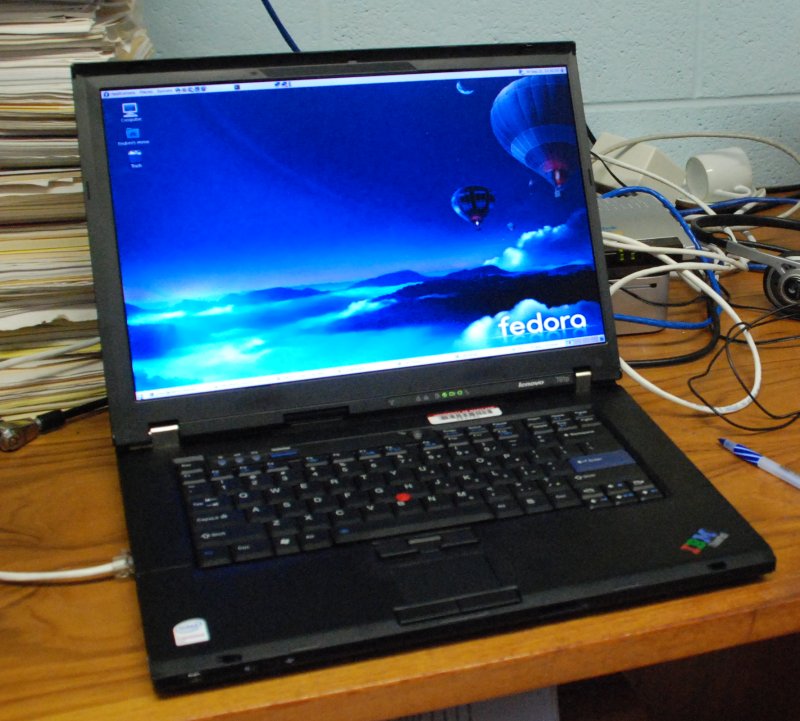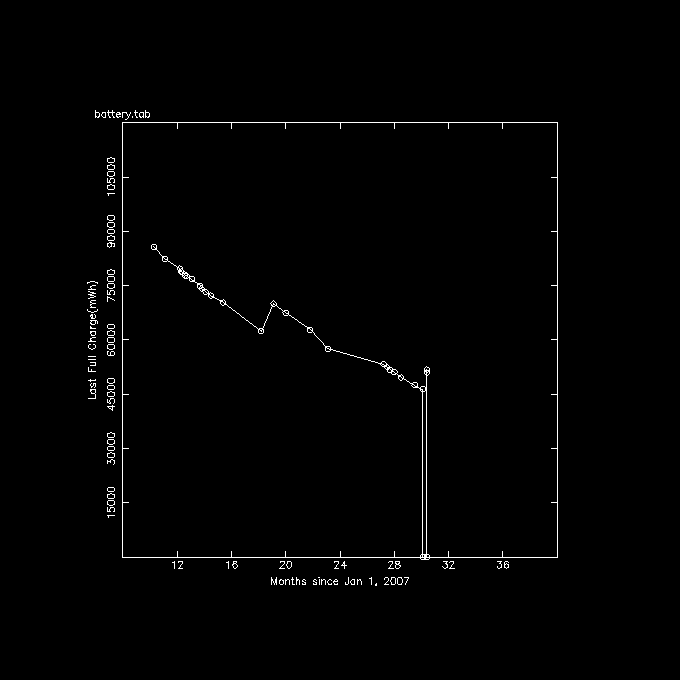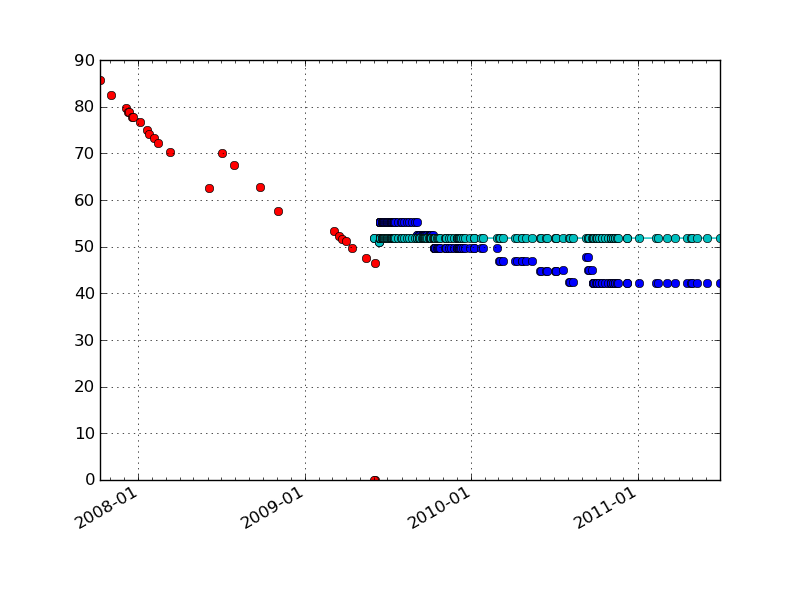

First impressions:
- first put the SATA (via BIOS) in compatibility mode .
Disk is /dev/sda, DVD is /dev/scd0, a dual layer writer
which appears to work fine.
- this NVIDIA card is not detected in FC7 (FC9 ok, see below),
so had to do the slightly more tedious non-graphical install.
After that was done, manually installed the NVIDIA driver, which then
worked out of the box (with a small caveat, see below)
- sounds doesn't work (known issue, can be solved by doing the ALSA
drivers yourself
** (17-feb-2008) finally got this to work with kernel 2.6.23.15-80.fc7
and the 1.0.16 also drivers from source (the kernel alsa didn't seem to
work for me)
- wireless sometimes works, not sure when and when not. Sometimes 10b/sec,
and i've seen 2MB/sec....
I've tried the latest 3945 drivers from scratch. seems to be same.
There is some suggestion that fixing the channel works better.
New kernel (2.6.22.9-91.fc7) gave a very well working wireles after the
first boot that then crawled to a halt and went back to the old mode.
installed ipw3945 via FreshRPMS. Now loads this by default. Speed
is only about 350 KB/s, but works (as eth1). Also notable is that
the frontpanel wireless light is now green, which iwlwifi wasn't doing.
** with newer kernels it pretty much works out of the box, though
occasionally a reboot would be needed to reset the drivers as they
sometimes get confused - ipw3945 is what i'm using with wlan0
- suspend to memory worked out of the box.
- hibernation ("suspending to disk", uses swsusp) doesn't seem to work
out of the box
** not yet tested with the new kernel and nvidia driver ***
** for a comparable model X61 and Ubuntu8 this worked out of the box **
- somewhat SERIOUS: screen updates in certain programs are very slow.
e.g. pgplot circles, OpenOffice programs, emacs scrolling
SOLVED: upgraded to NVIDIA-Linux-x86-100.14.19-pkg1.run, which
has explicit support for the FX 570M card.
- oddities:
suspend seems to work mostly, but sometimes it takes several
minutes (sometimes aided by some Ctr-Alt-Fn switching?);
patience seems to be the only way...
- some applications (notably firefox, thunderbird, pidgin) crash and burn
at random times. Not sure if that's me, or a relic of my . files
- at random times - gimp seems to trigger it more than others - the whole
desktop goes nuts as if doing a full refresh. Takes 10 secs or so to get
back to live. This is VERY annoying. Also worried if that's not just
me and my . files.
- this is the pits: a few application (secondlife, ifrit) actually
crash X. Nothing can be worse than that, short of locking up the
laptop.
- booted in safe mode, and came up utilizing full (wide) screen: nice - partition program scrashed.... could not continue. it filed a report seems to be that my /home is a symlink to a separare /home partition, and the "Migration assistant" couldn't quite figure it out. Solution: do /home later after the install.
After the install there was a failure from grub, luckily I had backed up /boot otherwise hard to get back to the other boots. Basically it was writing files in /boot, but no grub.conf. A manual fix (after putting back the old backup) helped. Next issue was that the gnome setup did not work well with the gnome files I had from the fedora's (between Fedora 7 and 9 also issues). However, a new user account worked fine. wow, gnome changing too fast.
As of mid september 2008 I'm now using Fedora 9. Things seem to work with kernel 2.6.25.14-108.fc9.i686, though a newer one (2.6.26.3-29.fc9.i686) is available but no nvidia driver. Suspend seems to work, the recovery of wireless works most of the time.
cute mystery: # df Filesystem 1K-blocks Used Available Use% Mounted on /dev/sda5 9920624 7348976 2059580 79% / tmpfs 1020732 0 1020732 0% /dev/shm /dev/sda7 201704368 188000916 3292132 99% /home /dev/sda1 1019208 67700 898900 8% /a1 /dev/sda2 9920624 7979356 1429200 85% /a2 /dev/sda3 9920624 7348976 2059580 79% /a3 Looks like sda5 and sda3 are the SAME!!!!??? # mount /dev/sda5 on / type ext3 (rw) <---- proc on /proc type proc (rw) sysfs on /sys type sysfs (rw) devpts on /dev/pts type devpts (rw,gid=5,mode=620) tmpfs on /dev/shm type tmpfs (rw) /dev/sda7 on /home type ext3 (rw) none on /proc/sys/fs/binfmt_misc type binfmt_misc (rw) sunrpc on /var/lib/nfs/rpc_pipefs type rpc_pipefs (rw) fusectl on /sys/fs/fuse/connections type fusectl (rw) /dev/sda1 on /a1 type ext3 (rw) /dev/sda2 on /a2 type ext3 (rw) /dev/sda3 on /a3 type ext3 (rw) <--- ]# fdisk -l /dev/sda Disk /dev/sda: 250.0 GB, 250059350016 bytes 255 heads, 63 sectors/track, 30401 cylinders Units = cylinders of 16065 * 512 = 8225280 bytes Device Boot Start End Blocks Id System /dev/sda1 * 1 131 1052226 83 Linux /dev/sda2 132 1406 10241437+ 83 Linux /dev/sda3 1407 2681 10241437+ 83 Linux <---- /dev/sda4 2682 30401 222660900 5 Extended /dev/sda5 2682 3956 10241406 83 Linux <---- /dev/sda6 3957 4478 4192933+ 82 Linux swap / Solaris /dev/sda7 4479 30401 208226466 83 Linux did I get a RAID1 installed by default??? # more /etc/fstab LABEL=/ / ext3 defaults 1 1 tmpfs /dev/shm tmpfs defaults 0 0 devpts /dev/pts devpts gid=5,mode=620 0 0 sysfs /sys sysfs defaults 0 0 proc /proc proc defaults 0 0 LABEL=SWAP-sda6 swap swap defaults 0 0 LABEL=/home /home ext3 defaults 1 2 # /dev/sda1 /a1 ext3 noauto 0 0 /dev/sda2 /a2 ext3 noauto 0 0 /dev/sda3 /a3 ext3 noauto 0 0 In the end i figured out this was the result of installing FC7 and FC8 and /boot. Manually fixed.
After selecting the usual additional development and web server options, 1521 packages were installed.
- suspend didn't seem to work out of the box, so back to fedora 9 :-(

or a new matplotlib style plot since the new battery (blue dots), since the old
one (red dots) catastrophically died just like that, while sitting in Atlanta Bread:

This page was last modified on 30-Jun-2011 by teuben@astro.umd.edu.